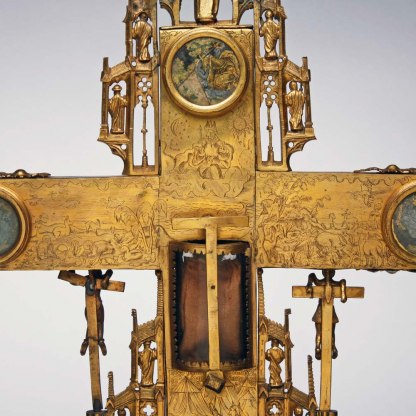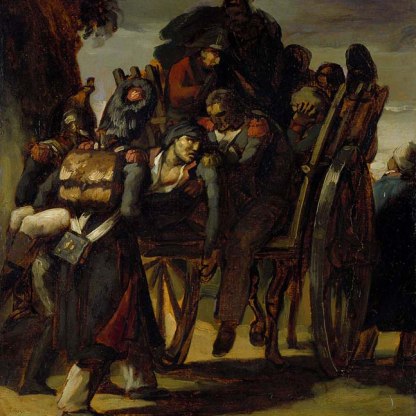Plaque from a Reliquary

'The humiliated bones will rejoice in the Lord.'
So says the Latin inscription on this enamel panel, the imagery of which illustrates that great promise from Psalm 51, 8. Two skulls, flanked by bones, stare out from two open coffins, the earthly remains of the two bearded men seated above. The palm fronds that the pair hold like royal sceptres are traditional symbols of victory. In Christian art they came to identify martyrs.
The men also wear crowns, and their heads are surrounded by bright haloes of turquoise, blue, gold, green and red. They are separated from their coffins by an undulating line made up of these same glowing colours – the boundary between the earthly and the heavenly realm. Stylised grape clusters and vine leaves fill the space between and behind them. From an early time these were symbols of Christ who said, in the Gospel of John, 16, 1–6: 'I am the real vine ... just as the branch cannot bear fruit by itself unless it abides in the vine, neither can you unless you abide in me.'
Grapes also suggest the wine of the Eucharist, Christ’s blood that was 'shed for many for the remission of sins' (Matthew, 26, 28).
The message, then, is one of hope beyond death and of the redemptive power of suffering. Having, like Christ, died violently on earth, the martyrs have found glory and exultation in heaven. Through Christ, the corpses have become kings. And for the medieval viewer, this affirmed Christ’s promise about the resurrection of the flesh at the Last Judgment:
'Every one which seeth the Son, and believeth on him, may have everlasting life; and I will raise him up at the last day.' (John, 6, 40)
Another panel, with very similar decoration, now in a private collection, has two other, almost identical figures. Both panels very probably come from the same chasse, a gable-ended, church-shaped reliquary. These often magnificent receptacles were built as containers for the bodily remains of saints, or the objects associated with them.
The appearance of four crowned men on the two related panels suggests that the chasse once contained relics associated with the Quattuor Coronati – ‘the four crowned saints'. These were early Christian martyrs who died under the regime of the Roman Emperor Diocletian (245–316 CE). A church dedicated to these Christian soldiers, left, had been erected in Rome by the fourth century, and there is evidence of their cult in Canterbury, England, in the seventh century.
Perhaps more significantly, some of their relics ended up in the cathedral of Saint-Sernin in Toulouse, about 150 miles from Limoges, where this enamel plaque was made. By the thirteenth century, Limoges was the leading European centre for enamelled goods. Enamel, with its bright range of colours which replicated the appearance of precious stones, was particularly appropriate for the decoration of reliquaries: the bones of the martyrs contained within were, from the earliest times, compared with jewels.
In its decoration, its inscription, its function and even its medium, then, the reliquary from which this panel comes, affirmed the Christian hope of bodily resurrection.
Themes and periods
Data from our collections database
Plaque from the gable end of a reliquary. Copper, champlevé, engraved, enamelled, in two shades of blue, green, red, and white, and gilt. Pentagonal with ten small circular holes situated at each corner and half-way along each side. Two crowned maryrs wearing long gowns, and each holding a palms in his left hand, are seated on a cross-hatched plank surrounded by scrolling stems bearing leaves, and between the figures, two cones, reserved in a blue ground. Under their feet is a gilt band bearing the inscription EXVLTABVNT: DÑO OSSA: HVMILIATA (The humiliated bones shall rejoice in the Lord) . Below it is a wavy band over two skewed rectangular coffins containing bones, and at the bottom of the plaque, diagonal wavy lines representing water.
Louis-Fidel Debruge-Duménil (1788-1838), Paris; sold Paris, Bonnefons de Lavialle, commissaire-priseur, 23 January - 9 February and 4-12 March, 1850, Catalogue des objets d’art qui composent la collection Debruge Duménil, p. 75, lot 81; Lord Hastings; Christie, Manson & Woods, 20 March 1888, Catalogue of majolica, Palissy ware, German stoneware, Limoges enamels, the property of The Right Hon. Lord Hastings of Melton Con¬stable, Norfolk, ADD; Frank McClean, Tunbridge Wells
Legal notes
Frank McClean Bequest
Acquisition and important dates
- Method of acquisition: Bequeathed
- Dates: 1904
Dating
Limoges champlevé enamels were made by gouging out a shallow recess in a hammered copper plate, which was filled with powdered glass. When heated this fused to become level with the divisions formed by the edges of the ‘fields’. The surface was then polished. The resulting images have bold linear modelling, and jewel-like colours. Early examples had gilded backgrounds, but by the thirteenth century blue predominated. The hands, feet and faces of figures were sometimes made separately, and were attached by means of rivets.
The matching gable end, formerly in the Keir Collection, is in the Thomson Collection in the Art Gallery of Ontario, in Toronto (2003/1325). It has an inscription from Psalm 33: 21: CVSTODIT D[OMI]N[V]S OMIA OSSA S[AN]C[T]OR[VM] The Lord keeps all the bones of the saints.
Maker(s)
- Unknown Workshop
Note
Limoges champlevé enamels were made by gouging out a shallow recess in a hammered copper plate, which was filled with powdered glass. When heated this fused to become level with the divisions formed by the edges of the ‘fields’. The surface was then polished. The resulting images have bold linear modelling, and jewel-like colours. Early examples had gilded backgrounds, but by the thirteenth century blue predominated. The hands, feet and faces of figures were sometimes made separately, and were attached by means of rivets.
The matching gable end, formerly in the Keir Collection, is in the Thomson Collection in the Art Gallery of Ontario, in Toronto (2003/1325). It has an inscription from Psalm 33: 21: CVSTODIT D[OMI]N[V]S OMIA OSSA S[AN]C[T]OR[VM] The Lord keeps all the bones of the saints.
Place(s) associated
- Limoges
Stories, Contexts and Themes
Other highlight objects you might like
Suggested Curating Cambridge products
Sign up to our emails
Be the first to hear about our news, exhibitions, events and more…







